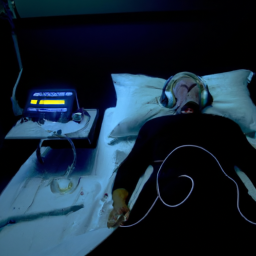Picture this: you’re sitting in a quiet room, savoring the tranquility of the moment. Suddenly, a high-pitched ringing pierces through the silence, drowning out all other sounds. You try to ignore it, but it persists, causing frustration and distress.
This is the reality for millions of people living with tinnitus, a condition characterized by persistent ringing, buzzing, or hissing in the ears.
The good news is that there is hope for relief. Recent research has uncovered a fascinating connection between hearing aids and tinnitus management. By addressing hearing loss, which often coexists with tinnitus, hearing aids have shown promising results in reducing the severity of symptoms and improving quality of life.
In this article, we will delve into the link between hearing aids and tinnitus, exploring the connection in depth. We will examine the symptoms and causes of tinnitus, as well as the different types of hearing aids that can assist in its management. We will also walk you through the consultation and fitting process for tinnitus relief, and share success stories and testimonials from those who have found solace through hearing aids.
Additionally, we will discuss other strategies for tinnitus management, providing a comprehensive approach to tackling this challenging condition. So, let’s embark on this journey together and discover how hearing aids can provide a lifeline for those suffering from tinnitus.
Key Takeaways
- Hearing aids can reduce the severity of tinnitus symptoms and improve quality of life.
- Different types of hearing aids, such as BTE, ITE, and IIC, can be used for tinnitus management.
- Approximately 60% of people experience a reduction in tinnitus symptoms with the use of hearing aids.
- Alternative strategies, such as relaxation techniques, lifestyle changes, sound therapy, acupuncture, cognitive behavioral therapy, and herbal supplements, can be used alongside hearing aids for tinnitus management.
Understanding Tinnitus: Exploring the Symptoms and Causes
If you’ve ever experienced a persistent ringing or buzzing in your ears, you’re probably familiar with the frustrating and sometimes debilitating symptoms of tinnitus. This condition affects millions of people worldwide and can have a significant impact on their quality of life. Understanding the symptoms and causes of tinnitus is crucial in exploring treatment options and finding relief.
Tinnitus can be caused by various factors, including exposure to loud noise, age-related hearing loss, earwax blockage, and certain medical conditions. It can manifest as a high-pitched ringing, buzzing, or hissing sound, and can be accompanied by dizziness, headaches, and difficulty concentrating.
Exploring treatment options for tinnitus involves a multidisciplinary approach, including sound therapy, counseling, and medication. Now, let’s delve into the role of hearing aids in tinnitus management, as they have shown promising results in alleviating symptoms and improving overall well-being.
The Role of Hearing Aids in Tinnitus Management
By incorporating hearing aids into tinnitus management, individuals can experience a profound improvement in their daily lives. Audiologists play a crucial role in this process, as they assess the severity of tinnitus and determine the appropriate hearing aid solution. Hearing aids offer several benefits for managing tinnitus, including sound amplification, masking, and distraction. They amplify external sounds, making the internal ringing or buzzing of tinnitus less noticeable. Additionally, some hearing aids are equipped with specific features, such as white noise generators or customized sound therapy programs, which can provide relief from tinnitus symptoms. These devices work by introducing pleasant sounds that help to mask or distract from the tinnitus. Overall, hearing aids offer a valuable tool in the management of tinnitus, providing individuals with improved quality of life and relief from the bothersome symptoms. Moving forward, let’s explore the different types of hearing aids available for tinnitus management.
Types of Hearing Aids for Tinnitus Management
When it comes to managing tinnitus, there are several types of hearing aids that can be used.
Behind-the-Ear (BTE) hearing aids are a popular option, as they provide a comfortable fit and can accommodate various degrees of hearing loss.
In-the-Ear (ITE) hearing aids are another choice, offering a discreet and customizable solution.
Lastly, Invisible-in-Canal (IIC) hearing aids are virtually invisible and sit deep within the ear canal, providing a natural sound experience.
Each type of hearing aid has its own unique benefits and features that can be tailored to suit individual needs in tinnitus management.
Behind-the-Ear (BTE) Hearing Aids
Wearing BTE hearing aids is like having a personal concert hall strapped behind your ear. These hearing aids come in various styles, including the traditional BTE style, the mini BTE style, and the receiver-in-canal (RIC) style.
Here are three reasons why BTE hearing aids are a popular choice for managing tinnitus:
-
Amplification: BTE hearing aids provide powerful amplification, allowing you to hear even the softest sounds. This can help distract you from the ringing or buzzing noises associated with tinnitus.
-
Customizable options: BTE hearing aids offer numerous customizable features, such as volume control, noise reduction, and tinnitus masking. These options allow you to tailor your hearing aids to your specific needs and preferences.
-
Comfort and convenience: BTE hearing aids are known for their comfortable fit and easy handling. They’re also suitable for individuals with different degrees of hearing loss.
Now, let’s delve into the next section about in-the-ear (ITE) hearing aids and explore their unique benefits.
In-the-Ear (ITE) Hearing Aids
Experience the convenience and discreetness of in-the-ear (ITE) hearing aids as they seamlessly blend into your daily life. ITE hearing aids are designed to fit snugly in your ear canal, providing a comfortable and natural listening experience.
The latest ITE hearing aid technology incorporates advanced features such as noise reduction, feedback cancellation, and directional microphones, allowing you to hear speech and sounds with clarity and ease. These custom fit hearing aids are individually crafted to match the unique shape and size of your ear, ensuring a secure and personalized fit.
With ITE hearing aids, you can enjoy improved hearing without compromising on style or comfort.
Transitioning into the subsequent section about ‘invisible-in-canal (iic) hearing aids’, you can further explore the latest advancements in discreet hearing aid technology.
Invisible-in-Canal (IIC) Hearing Aids
The small size and placement deep within the ear canal make invisible-in-canal (IIC) hearing aids an attractive option for those seeking a discreet and natural hearing solution. These hearing aids are custom-made to fit comfortably and securely in the ear canal, making them virtually invisible to others. The discreet design allows individuals to confidently wear the hearing aids without drawing attention.
Despite their small size, IIC hearing aids still offer advanced technology and features to improve hearing ability. Customization options are available to ensure a precise fit and optimal performance. During the consultation and fitting process for tinnitus relief, the audiologist will discuss the benefits of IIC hearing aids and determine if they’re the right option for you.
Consultation and Fitting Process for Tinnitus Relief
During the consultation and fitting process for tinnitus relief, you’ll be amazed to learn that approximately 60% of people experience a reduction in their tinnitus symptoms with the use of hearing aids. The consultation process involves meeting with a hearing healthcare professional who will assess your hearing and tinnitus needs. They will gather information about your tinnitus, including its severity and any associated hearing loss. The fitting process begins once you have selected the appropriate hearing aids for your tinnitus. The hearing aids will be programmed to provide specific sound therapy that can help mask or reduce the perception of tinnitus. This may involve adjusting the volume, frequency, or type of sound delivered by the hearing aids. The table below summarizes the consultation and fitting process for tinnitus relief:
| Consultation and Fitting Process for Tinnitus Relief |
|---|
| 1. Meet with a hearing healthcare professional |
| 2. Assess hearing and tinnitus needs |
| 3. Gather information about tinnitus |
| 4. Select appropriate hearing aids |
| 5. Program hearing aids for sound therapy |
These steps are crucial in finding the best solution for managing tinnitus. Now, let’s explore the success stories and testimonials of individuals who have successfully managed their tinnitus with the help of hearing aids.
Managing Tinnitus with Hearing Aids: Success Stories and Testimonials
Now that you have a better understanding of the consultation and fitting process for tinnitus relief, let’s delve into the success stories and testimonials of individuals who’ve managed their tinnitus with hearing aids.
These stories offer a glimpse into the transformative power of this solution for tinnitus sufferers. Many individuals have reported significant improvements in their tinnitus symptoms, including reduced intensity and increased ability to focus on external sounds. They’ve regained control over their lives and experienced a newfound sense of relief and peace.
These success stories highlight the effectiveness of using hearing aids as a management tool for tinnitus. However, it’s important to note that while hearing aids have been successful for many, they may not be the only solution for everyone.
In the next section, we’ll explore other strategies for tinnitus management.
Other Strategies for Tinnitus Management
Explore alternative methods to manage your tinnitus and find relief beyond the use of hearing aids. While hearing aids can be effective in reducing tinnitus symptoms for many individuals, there are other strategies and therapies that can complement their benefits. Consider incorporating alternative therapies into your tinnitus management plan. These may include relaxation techniques, such as meditation or yoga, to reduce stress levels that can exacerbate tinnitus. Lifestyle changes, such as getting regular exercise, maintaining a healthy diet, and avoiding triggers like caffeine or loud noises, can also have a positive impact on tinnitus. Additionally, sound therapy, which involves using external noises to mask or distract from tinnitus sounds, can be helpful. Remember, finding the right combination of strategies for your unique needs is key to finding relief from tinnitus.
| Alternative Therapies | Lifestyle Changes | |||
|---|---|---|---|---|
| Acupuncture | Stress Reduction | |||
| Cognitive Behavioral Therapy | Regular Exercise | |||
| Herbal Supplements | Healthy Diet | Sound Therapy | Meditation and Relaxation Techniques |
Frequently Asked Questions
Can hearing aids cure tinnitus completely?
No, hearing aids can’t completely cure tinnitus. However, they can be highly effective in managing the symptoms and providing relief. Extensive tinnitus research has shown that hearing aids can significantly reduce the perception of tinnitus by amplifying external sounds and diverting attention away from the internal ringing or buzzing.
While not a complete cure, hearing aids are a valuable tool in improving the quality of life for individuals with tinnitus.
Are there any side effects of using hearing aids for tinnitus management?
Using hearing aids for tinnitus management can have some side effects, but they’re generally mild and temporary. Common side effects include discomfort, ear canal irritation, and an increase in tinnitus symptoms initially. However, these side effects usually subside as your brain adjusts to the amplification provided by the hearing aids.
Overall, the effectiveness of hearing aids for tinnitus management is well-established, making them a valuable tool in reducing tinnitus distress.
How long does it take for hearing aids to provide relief from tinnitus symptoms?
Hearing aids can provide relief from tinnitus symptoms, but the timeline for this relief can vary. It typically takes some time for your brain to adjust to the sounds amplified by the hearing aids.
Generally, it can take a few weeks to a few months to experience significant improvement in tinnitus management. However, the effectiveness of hearing aids in tinnitus relief depends on factors such as the severity of tinnitus and individual response to treatment.
Can children with tinnitus also benefit from using hearing aids?
Children with tinnitus can indeed benefit from using hearing aids. The management of pediatric tinnitus is crucial, and hearing aids play a significant role in providing relief. These devices not only amplify sound but also help mask the tinnitus noise, improving the child’s overall auditory experience. By enhancing their ability to hear external sounds, hearing aids can reduce the prominence of tinnitus, leading to improved quality of life for young individuals with this condition.
Are there any alternative treatments for tinnitus besides using hearing aids?
Yes, there are alternative therapies available for tinnitus besides using hearing aids. One such option is mindfulness techniques, which can help individuals manage the distressing symptoms associated with tinnitus.
Mindfulness involves focusing on the present moment and accepting one’s thoughts and feelings without judgment. This practice has shown promising results in reducing tinnitus-related distress and improving overall well-being. However, it’s important to consult with a healthcare professional before trying any alternative treatments for tinnitus.
Conclusion
In conclusion, if you’re experiencing the distressing symphony of tinnitus, fear not, for there’s hope in the form of hearing aids. These remarkable devices have shown promising results in managing tinnitus symptoms, providing relief, and restoring harmony to your auditory world.
By consulting with a professional and undergoing the fitting process, you can embark on a journey towards tinnitus relief. So, don’t hesitate to explore this link between hearing aids and tinnitus and discover the sweet melody of serenity once again.




